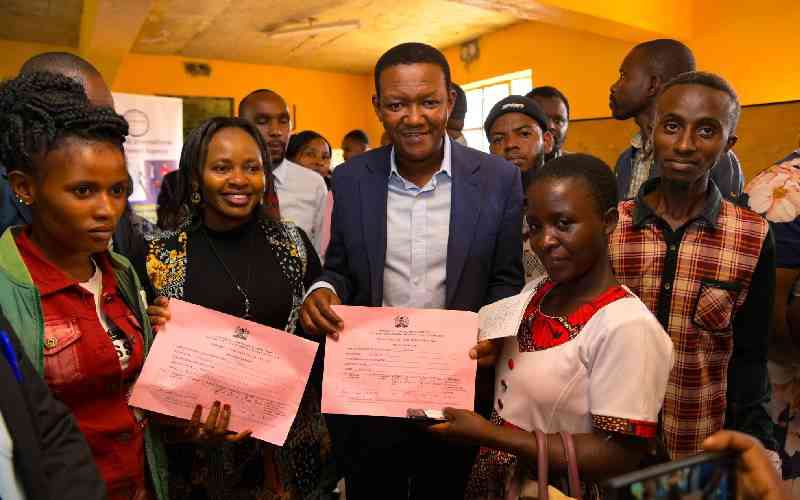Justifiably, most flinched at the presence of a military officer representing Nairobi County residents at the Thursday Cabinet meeting. Less attention was placed on some of the important decisions taken.
One of them was Cabinet approval for the Mukuru Social Housing Project. The decision is a significant leap forward for the right to housing, especially for people living in poor and informal settlements.
Imagine living in a community where 234 of your neighbours share one water tap and 67 line up regularly to use the same toilet. This is a familiar experience for 300,000 citizens who live on the 650 acres of Mukuru kwa Reuben, Njenga and Viwandani. Mukuru has one of the highest population densities in the country. It is also prone to flooding during the rainy season. Mukuru’s proximity to industrial factories that produce many of the products in your homes, violates their right to a clean and healthy environment. It leaves most constantly in a state of pollution and risk.
Remember the Sinai oil pipeline explosion that killed 90 people? That happened here. Cartels control basic services, causing electricity and water to cost 142 per cent and 300 per cent more than most Nairobi homes. A mere 230 landowners have titles to Mukuru but very few live or do business there. At least 94 per cent of those that live, work and play here are tenants or tenants of tenants.
The Cabinet decision to approve the implementation of the Mukuru Social Housing Project is not the first social housing programme in Kenya’s history. Jericho, Lumumba, Huruma, Kariobangi South and Harambee estates are among some of Kenya’s visionary housing projects in the 1960s and 1970s. The Mukuru project is, however, the first substantive initiative since the Constitution was passed a decade ago.
Under the programme, Sh15 billion will be invested by public, private and community institutions to build 13,000 housing units. It is a significant step towards Jubilee’s vision of adequate and dignified housing for all. It is also a best practise model of participatory, bottom-up planning that breathes life into Article 66 of the Constitution and the Physical Planning Act (2012).
The programme demonstrates an important concession by a county government that conventional planning cannot transform the lives of those who live in slums. It takes a Special Planning Area and integrated development approach. Not just houses, but environmental conservation, water, health and sanitation services, informed and accountable to communities who live there.
The path to this moment has taken a decade of community consultations, research and policy dialogue. The community may have been absent at the Thursday Cabinet meeting, but Muungano wa Wanavijiji, Slum Dwellers International, Akiba Mashinani Trust and community leaders have also created the path to this Cabinet decision.
We should acknowledge national, Nairobi County and Nairobi Metropolitan Services officers who have supported this collaborative approach. Despite public participation being a legal directive for all public programmes, there are too many autocratic and non-transparent projects. Unprotected by the public, these projects have ended up in the reports of the Auditor General or worse still, as evidence incriminating State officers in courts.
Only public participation and ownership can safeguard public investment. The sorry stories of pavements destroyed by PSV vehicles, playgrounds grabbed by politicians, or streetlights and manholes stolen by thieves cannot be stopped by county governments alone. Public involvement and vigilance are needed.
Released last month, the Kenya National Bureau of Statistics tell us one in three Kenyans remain financially poor. They are increasingly found in urban areas and deprived of essential services. The majority are under the age of 18. Perhaps the Cabinet could take a walk in Mukuru one day and see the possibilities for all national planning. They and the other 47 county cabinets could do no better than dust off the 2016 Devolution Ministry County Public Participation Guidelines and use them to guide all future programmes.
Can we see Special Planning Areas for Kibera, Kisumu Ndogo, Mnazi Mmoja and all urban areas where 23.4 million people live and earn less than Sh6,000 a month? Is there a model for an NMS facing consistent criticism that they are disinterested in public engagement? A word of caution for the tenderpreneurs: there may be no financial gain for their greed, only the possibility of transformative development for millions. Mukuru communities and State officers should now guard against elite capture of these 13,000 housing units. Mass housing is housing for the masses not the powerful and privileged.
- The writer is Amnesty International Executive Director. The views are personal. Email: [email protected]
 The Standard Group Plc is a
multi-media organization with investments in media platforms spanning newspaper
print operations, television, radio broadcasting, digital and online services. The
Standard Group is recognized as a leading multi-media house in Kenya with a key
influence in matters of national and international interest.
The Standard Group Plc is a
multi-media organization with investments in media platforms spanning newspaper
print operations, television, radio broadcasting, digital and online services. The
Standard Group is recognized as a leading multi-media house in Kenya with a key
influence in matters of national and international interest.
 The Standard Group Plc is a
multi-media organization with investments in media platforms spanning newspaper
print operations, television, radio broadcasting, digital and online services. The
Standard Group is recognized as a leading multi-media house in Kenya with a key
influence in matters of national and international interest.
The Standard Group Plc is a
multi-media organization with investments in media platforms spanning newspaper
print operations, television, radio broadcasting, digital and online services. The
Standard Group is recognized as a leading multi-media house in Kenya with a key
influence in matters of national and international interest.









